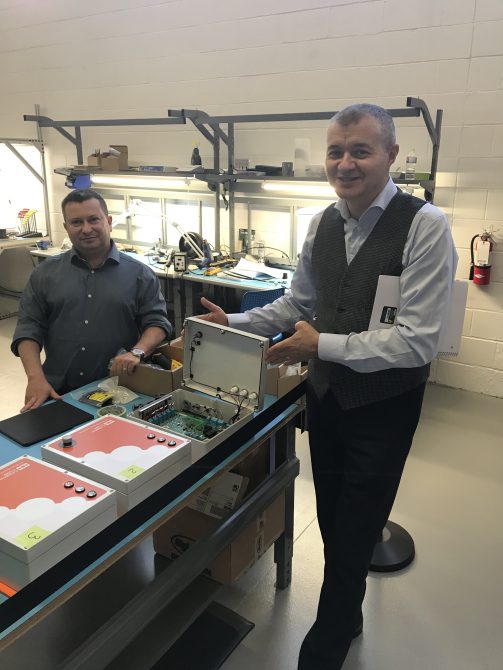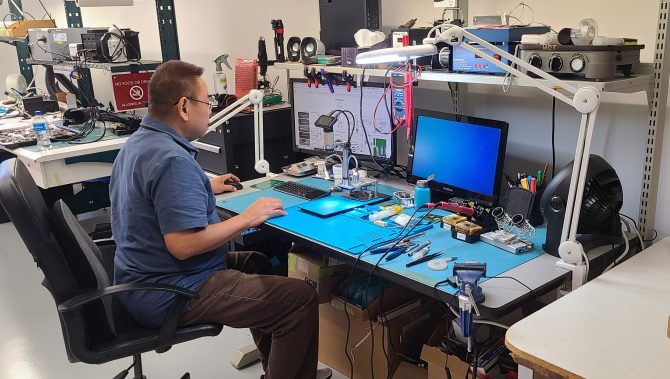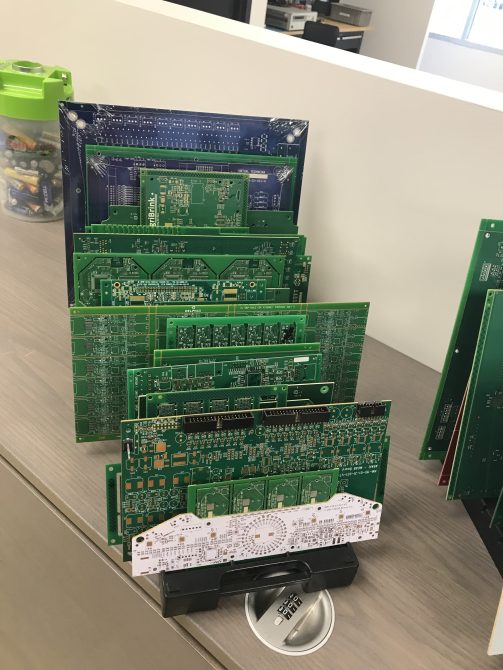
Deepening customer relationships via production capability
By Stephen Law, Editor EP&T
Electronics Contract Manufacturing Engineering contract design Editor Pick ManufacturingNeuronicWorks extends capabilities beyond design process - adds box build, SMT pcba services
Working closely with customers through the engineering stages of an electronic design is an obvious part of the process for Titu Botos CEO of NeuronicWorks. That is until now, after operating strictly as a design house in Toronto, the firm has boldly taken the next, most logical step towards deepening its relationship with the customer. Earlier this year, the company has added a fully integrated, turnkey, custom box build assembly & SMT pcba services – capable of delivering timely prototyping services and full production runs.
NeuronicWorks is now capable of seeing projects through from initial design stage to prototyping, testing and certification, supply chain and inventory management, manufacturing, shipment & logistics and end-user delivery. Since its beginning, NeuronicWorks has focused solely on design, a process which Botos says can last months to a year depending on any given project.

NeuronicWorks CEO Titu Botos says his firm’s next target is to try and keep most if not all future customer designs in-house – right to the shipping of final product. Pictured here, Botos (at right) displays a customer’s box-build design with Alexander Hasmany, director of business development. Source: Stephen Law, EP&T.
“We examined our relationships with many clients. And, close partnering is necessary through the design process. But, ultimately what happens next is that customer would take their Gerber files and head off to someone else to have it made, most often a contract manufacturer,” explains Botos. “So we looked at what was necessary to continue to remain with our customers – right through the duration of their journey. We have received very good response from our existing customer base, as they appreciate that we can serve them longer.”
Keep customers engaged
Having moved into a larger facility last year, the production area is spread over 22,000-sq-ft, housing box assembly and SMT assembly services. The newly expanded facility with state-of-the-art equipment can accommodate significantly higher production runs, while providing the ability to handle larger, more complex projects seamlessly out of one location. The production numbers and capabilities vary between big and small projects.
“Obviously, we cannot get involved in production requirements within the 10,000 to 50,000-range, however, it was natural for us to attach to the design something that represents a logical next step in the process for our partners, our customers,” says Botos. “Moving forward, our team will only get more experience and ultimately get better at these (production) processes. Our goal is to keep our customers engaged with us longer.”

NeuronicWorks is described as a design manufacturing house, specializing in product development and in-house manufacturing. Source: NeuronicWorks
With turnkey integrated services, NeuronicWorks now offers the ability to handle end to end design, prototyping, certification, pilot, high-mix, low volume manufacturing, and inventory and supply chain management out of one location. Having both design engineering and manufacturing services vertically integrated will shorten the NPD cycle, highly increasing NPI efficiency.
“This addition represents the biggest leap of faith financial investment in this next step represents a huge leap of faith,” Botos says.
Turnaround time on projects is highly dependent on the complexity of any given project, he says, adding that small, less complicated designs can be done in three months – while larger, more complex projects could require up to nine to 12-months to complete. Printed circuit board (pcb) manufacturing will remain outsourced, however the pcb assembly is now done on premise, using the firm’s recently acquired equipment, such as pick-and-place, paste application, AOI & X-ray inspection, curing oven, dry cabinets, and an inventory system.
“Being guided by a constant demand for low volume manufacturing support, we believe the next natural step for our growth as a company is to enter into high mix, low volume manufacturing services that will complement our design services allowing us to serve a full spectrum of services,” Botos says. “With design engineering, prototyping and manufacturing services seamlessly provided under one roof, our customers gain benefits that include seamless design transfer, increased productivity, high quality, reduced time and competitive pricing. Our pcba and SMT production services will produce state of the art designs incorporating best-in-class manufacturability and testability standards enabling faster development cycles.”
Box-build assembly
For some customers that fit into the high mix and low volume category, we can easily manage production runs of say 175 – and for some customers that is all they require to be happy, because of the nature of their design. Depending on the complexity of any design ultimately determines whether or not NeuronicWorks can accommodate – prior to enlisting outside support from a CEM, according to Botos. For example, if the electronic device is the size of a cellphone, NeuronicWorks is equipped to product 5,000-units per month, including box assembly, while still entertaining three or four separate clients at the same time.

Source: Stephen Law, EP&T
The next step in the firm’s evolution will include adoption of a new enterprise resource planning (ERP) system. The software platform will be used to manage day-to-day business activities such as accounting, procurement, project management, risk management and compliance and supply chain operations. In the end, it will enhance or streamline the customer’s experience, according to Botos.
“This ERP system will help us grow, as it will represent full integration of design and manufacturing, making everything much easier to follow – from managing job orders, staffing, design changes,
In May of this year, NeuronicWorks achieved ISO for its process in both design to production, which opens the door to accepting more complex designs, according to Alexander Hasmany, B.Sc, director of business development at NeuronicWorks. One of the mainstay or key design areas for NeuronicWorks has always been industrial automation / instrumentation, and industrial controls. Other of importance have included designs in the automotive, medical, wearables, consumer electronics, green energy, and home automation.
“The design process becomes more seamless to our customer, as our facility now serves as a one-stop shop and we take full responsibility for the complete design, from design to prototype to testing, certifications and manufacturing,” says Hasmany. “The seamlessness of having everything under one roof makes us more nimble and reactive to any issues that may arise through any design/manufacturing process,” he adds.
Among its added services is product testing, which in many cases involves customizing the test process for individual projects and customers, says Hasmany.
Plans to expand
“If a customer wants us to test all 100 or 1,000 of their end designs before shipping, we have a capabilities to do so – to verify with a certification sticker on the end product,” he says.
Botos recently extended the lease on the firm’s Toronto facility. NeuronicWorks also operates another design-only office situated inside Catalyst137, a IoT themed design hub in Kitchener ON. It operates in a 5,000-square-feet office. At present, Botos describes his design team as “small”, but has plans to actively expand.
“As our business continues to grow, we understand that with every new client – there is a learning curve for all involved,” he concludes.
